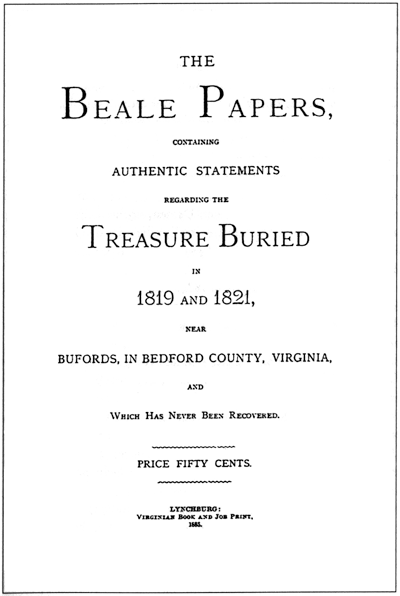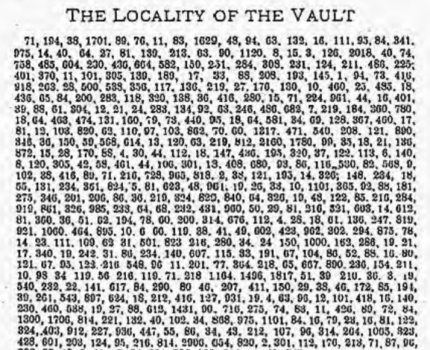
The story of the Beale Treasure is one of mystery. It was first brought to the public’s attention in 1885 by way of a pamphlet published by James B. Ward. The fifty cent booklet detailed circumstances in which an immense treasure was buried, and included coded messages left on how to find the secret stash of gold, silver, and other jewels. If a person solved the codes, he would supposedly be led to all that was hidden.
The following full title of pamphlet certainly captured interest at the time; The Beale Papers, containing authentic statements regarding the treasure buried in 1819 and 1821, near Bufords, in Bedford County, Virginia, and which has never been recovered. Today, since no confirmation of the treasure has ever surfaced (other than the Beale Papers), some people believe the buried treasure was just part of a tale. Others, however, feel there is something real, yet to discover. No one knows for sure.
The Beale Papers relate how a safe box, which contained three coded messages and two letters written by a gentleman named Thomas J. Beale, was left with another man named Robert Morriss in the spring of 1822. The first letter in the box told of the discovery of gold, some 250 to 300 miles north of Santa Fe. The gold was found by a group of men led by T.J. Beale. In efforts to ensure this treasure stayed safe (while they continued on other adventures), this group of thirty men decided to transport the treasure back to Virginia (where they were familiar), and bury it. Two trips were made to deposit the treasure; one in 1819 and the other in 1821.
The letter also explained the unintelligible notes placed within the safe box were codes. When used with a key, that was later to be sent (but never was), these would reveal the exact location of the buried treasure, the contents, and names of Beale’s party. The second letter in the box was a short note, stating again, that one of the coded papers included names of the men involved.
Included also within the Beale Papers pamphlet was a copy of a letter sent by Beale to Mr. Morriss in May, 1822. This letter was sent from St. Louis soon after leaving the box in Mr. Morriss’ care. The letter gave further instructions concerning the opening of the box. It informed Mr. Morriss to remove the lock, if after 10 years, Beale, or any of the men, did not return. It mentioned a key would need to be used in order to understand the full meaning of the papers kept in the box, and that this key would be sent in June of 1832 by someone instructed to do so in St. Louis.
Neither Beale, nor any other man, returned. After waiting until 1845, longer than needed, Mr. Morriss is said to have opened the box and learned what it contained. Unable to ever decode any of the papers, Morriss passed the responsibility on to the ‘author’ of the tale in the pamphlet.
It has been suggested J.B. Ward, instead of acting as agent for the story, is the actual author of the work. Inconsistencies noticed, and analysis of the various letters, involved in the story, seems to support this theory. This is not fact, though.
No matter whom Mr. Morriss passed the box and letters on to, the pamphlet opens with the person giving up his quest for the buried treasure. Even though he reveals in the papers how he ‘accidentally’ decoded one of the three coded messages that told of the vast worth of the treasure, and was excited by such, he says that he “is compelled, however unwillingly, to relinquish to others the elucidation of the Beale Papers…”. His hopes were for someone else to solve the codes and find the fortune, so he could rejoice with them. He had already spent over twenty years (the best years of his life) attempting to locate the buried treasure and could not spend any more time on the matter.
The one code in which the author cracked was accomplished by using the Declaration of Independence as a Key. The three coded papers all consisted of sets of numerous numbers. The second paper in the series, when taking the first letter of the matching numbered word in the Declaration, provided a letter for the following decipherment (without mistakes):
“I have deposited in the county of Bedford, about four miles from Buford’s, in an excavation or vault, six feet below the surface of the ground, the following articles, belonging jointly to the parties whose names are given in number “3” herewith; The first deposit consisted of one thousand and fourteen pounds of gold, and three thousand eight hundred and twelve pounds of silver, deposited November, 1819. The second was made December, 1821, and consisted of nineteen hundred and seven pounds of gold, and twelve hundred and eighty eight pounds of silver; also jewels, obtained in St. Louis in exchange for silver to save transportation, and valued at 13,000. The above is securely packed in iron pots, with iron covers. The vault is roughly lined with stone, and the vessels rest on solid stone, and are covered with others. Paper number “1” describes the exact locality of the vault, so that no difficulty will be had in finding it.”
The other two papers written with sets of numbers (giving the exact location and names), when applied to the Declaration in the same manner as the second, does not provide any coherent messages.
Numerous searchers, of course, have hunted for the treasure ‘four miles from Buford’s’ and have come up empty. Many have also attempted to decipher the remaining two codes.
The mystery of the Beale Papers continues. Was it all a hoax? Is there a treasure yet to be found?
These questions may remain unanswered until the final two codes are able to be deciphered. And this leaves one of the biggest questions; Do the sets of numbers actually reveal a message or, if it was a hoax, or they randomly picked and offer nothing?
Obviously, analysis has been done to determine if the numbers are ‘random’. What they suggest is inconclusive. And so, the possibility exists the codes (and the entire story) are actually hiding ‘something’ and this is what I will be investigating in my spare time.
The Beale Papers contain a message to those who want to explore the Beale Mystery (or any mystery/treasure). It is as follows:
“Again, never as I have done, sacrifice your own and your family’s interests to what may prove an illusion; but, as I have already said, when your day’s work is done, and you are comfortably seated by your good fire, a short time devoted to the subject can injure no one, and may bring its reward.”
The above, to realize no fantasy for riches is worth sacrificing true treasures for, may be the real reward of the Beale Papers.
More Posts on The Beale Treasure: The Beale Treasure
.
Feel free to Follow/friend me on facebook for further posts on this and other mysteries.

